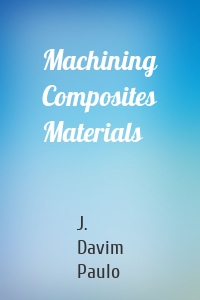J. Davim Paulo
8 кн.
Mechatronics
The term Mechatronics is a combination of the words “mechanics” and “electronics”. It is the blending of mechanical, electronic, and computer engineering into an integrated design and implementation. Mechatronics systems employ microprocessors and software as well as special-purpose electronics. The main objective of this interdisciplinary engineering field is the study of automated devices (e.g. robots) from an engineering perspective, thinking about the design of products and manufacturing...
| Автор | J. Davim Paulo |
Machining Composites Materials
In recent years, the application of composite materials has increased in various areas of science and technology due to their special properties, namely for use in the aircraft, automotive, defence, aerospace and other advanced industries. Machining composite materials is quite a complex task owing to its heterogenity, and to the fact that reinforcements are extremely abrasive. In modern engineering, high demands are placed on components made of composites in relation to their dimensional...
| Автор | J. Davim Paulo |
Biotribology
Tribology is the “science and technology of interacting surfaces in relative motion” and encompasses the study of friction, wear and lubrication. By extension biotribology is usually defined as the tribological phenomena occurring in either the human body or in animals. Therefore, it is possible to consider tribological processes that may occur after implantation of an artificial device in the human body and the tribological processes naturally occurring in or on the tissues and organ of...
| Автор | J. Davim Paulo |
Mechanical Engineering Education
Mechanical Engineering is defined nowadays as a discipline “which involves the application of principles of physics, design, manufacturing and maintenance of mechanical systems”. Recently, mechanical engineering has also focused on some cutting-edge subjects such as nanomechanics and nanotechnology, mechatronics and robotics, computational mechanics, biomechanics, alternative energies, as well as aspects related to sustainable mechanical engineering. This book covers mechanical engineering...
| Автор | J. Davim Paulo |
Sustainable Manufacturing
According to the NACFAM (National Council for Advanced Manufacturing USA) Sustainable Manufacturing is defined as the creation of manufactured products that use processes that are non-polluting, conserve energy and natural resources, and are economically sound and safe for employees, communities, and consumers. The book covers Sustainable Manufacturing techniques such as materials and manufacturing for renewable energies; clean manufacturing technology; ecological manufacturing; energy-efficient...
| Автор | J. Davim Paulo |
Laser in Manufacturing
Generally a laser (light amplification by stimulated emission of radiation) is defined as “a device which uses a quantum mechanical effect, stimulated emission, to generate a coherent beam of light from a lasing medium of controlled purity, size, and shape”. Laser material processing represents a great number of methods, which are rapidly growing in current and different industrial applications as new alternatives to traditional manufacturing processes. Nowadays, the use of lasers in...
| Автор | J. Davim Paulo |
Wood Machining
Wood as an engineering material can be technically defined “as a hygroscopic, orthotropic, biological, and permeable material having extreme chemical diversity and physical complexity with structures, that vary extensively in their shape, size, properties and function”. Therefore, using wood to its best advantage and most efficiency in engineering applications, specific characteristics or chemical, physical and mechanical properties must be considered. The products are divided into two classes,...
| Автор | J. Davim Paulo |
Nano and Micromachining
This book provides the fundamentals and recent advances in nano and micromachining for modern manufacturing engineering. It begins by outlining nanomachining before discussing various advances in field and machining processes. The coverage concludes with an evaluation of subsurface damages in nano and micromachining and a presentation of applications in industry. As such, this book serves both as a useful classroom text for engineering and machining courses at the undergraduate and graduate...
| Автор | J. Davim Paulo |









